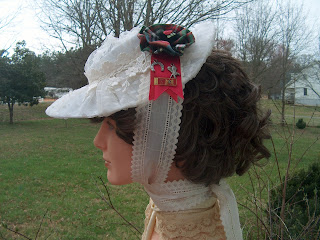March: Sewing Kit: create an item that makes use of your favorite sewing tool, instrument, or gadget: or an item made for your historical sewing kit.
The Dreamstress
This project started many, many, many years ago and ended today. A group of ladies were attending a costume convention and decided to make a Victorian gown representing our individual states. While North Carolina is not my home state, it is my husband's home state and we have lived here since 2002. From mountains to ocean coast - we have it all. The weather is temperate and there are four beautiful seasons. I love it here!
I did make my Victorian tribute gown that many years ago but a family emergency kept me from attending the convention. The skirt and bodice were stored along with some beautiful leftover Carolina Tartan fabric.
The Carolina Tartan was designed and registered with the Scottish Tartans Society in 1981 by Peter MacDonald of Crieff, Scotland. ... It was made the official tartan of North Carolina in 1991 when it was passed by the North Carolina General Assembly.
Last year Truly Victorian issued a new pattern for an 1878 Polonaise and I was excited to create something from the pattern. As happens easily with fitted Victorian garments, the bodice from my original North Carolina Tribute Gown no longer fit the older me but the red silk fantail skirt could be adjusted. With some leftover red silk and the leftover Carolina Tartan fabric I had just enough to create another Tribute Gown. Yay!!
The pattern is very straightforward and sews together beautifully. The most difficult part is the long pattern pieces which I kept organized by pinning to my dressform. For structure I interlined/flatlined the entire gown with red cotton. In these photos I'm also trying some trim and buttons to see if I like what I'm thinking of using. I do this often in my sewing so that I can really tell if I love something the minute I see it on the partially completed piece.
These photos are the completed gown ready for collar, buttons, and trim. The pocket was trimmed before it was sewn to the gown. The pattern looks simple but there are a lot of drawstrings and pleats to give the beautiful silhouette. I omitted the front darts from bust to waist to keep the tartan plaid smooth.
All of the trim and embellishment for this gown is a tribute to the State of North Carolina. On the pocket is a Cardinal, our State Bird, sitting on a Pine branch, our State Tree. On one sleeve edge is our State Instect, the honeybee. The waterfall trim is reflective of our State Flower, the Dogwood Blossom, and the Great Seal is at the lower front edge of the polonaise. Our State Colors of red and blue are in the silk, the Tartan, and the blue vintage buttons from Germany. A wonderful costumer was selling these buttons and not only were there enough but they have a bird on them that looks like a Cardinal!
The Truly Victorian pattern has an illustration with View A showing the most amazing bows at the pleated parts of the front and sides of the polonaise. I love bows! But I hate making them because they always seem to come out lopsided. Debbie is a friend and fellow costumer and she has become a US distributer of an item from an Italian company established in 1931. The minute I heard about this gadget that would create bows, rosettes, and tassels I knew it was for me. Tassels for my parasols and fans!! And beautiful, non-lopsided bows! Heaven!
This is my new and much loved gadget, La fiocchetteria and my first bow.
This is a video of one of their tutorials: Bow Maker
Now with all of the symbols, trim, and beautiful bows, here is my finished Tribute to the State of North Carolina Gown and a little hat made from Ageless Patterns #1525 to complete the costume.
 |
| Bows! Bows! Bows! |
Historical Sew Monthly
The Challenge: Sewing Kit
How this fits: Making bows from a gadget.
Material: Bows: Linen ribbon Gown: Silk dupioni, wool blend tartan
Pattern: Truly Victorian TV430 1878 Polonaise
Year: Bow/Tassel Maker: 1931 Gown: 1878
Notions: Lace, state embroidered emblems, lace applique, bias tape for casings, grosgrain ribbon for drawstrings, buttons
How historically accurate is it? Pattern developed from historical illustrations and historical sewing techniques used.
Hours to complete: 55 hours
First worn: Not yet
Total cost: $315
.jpg)




















































































